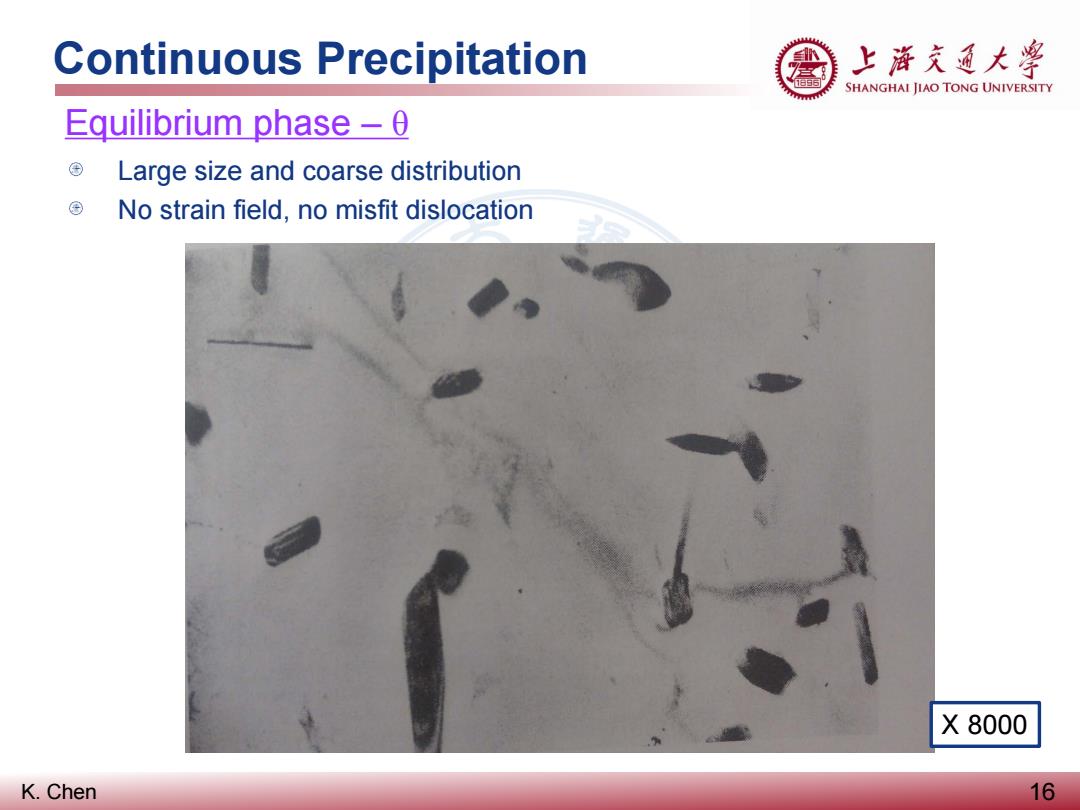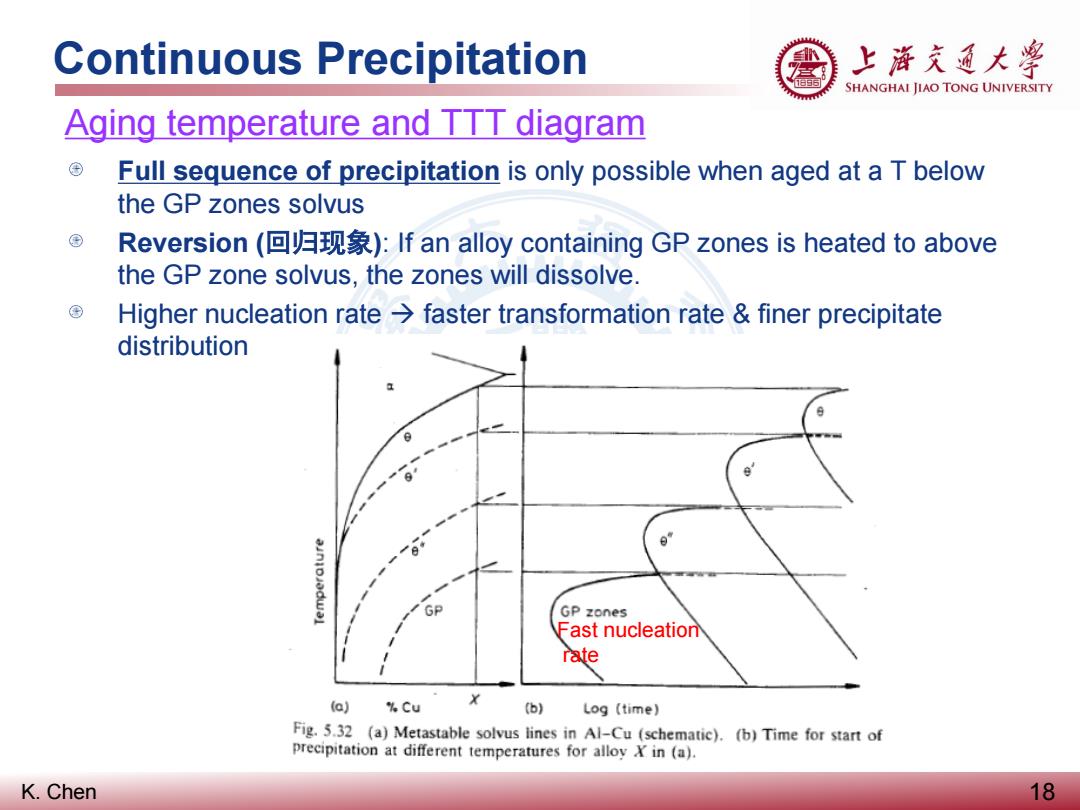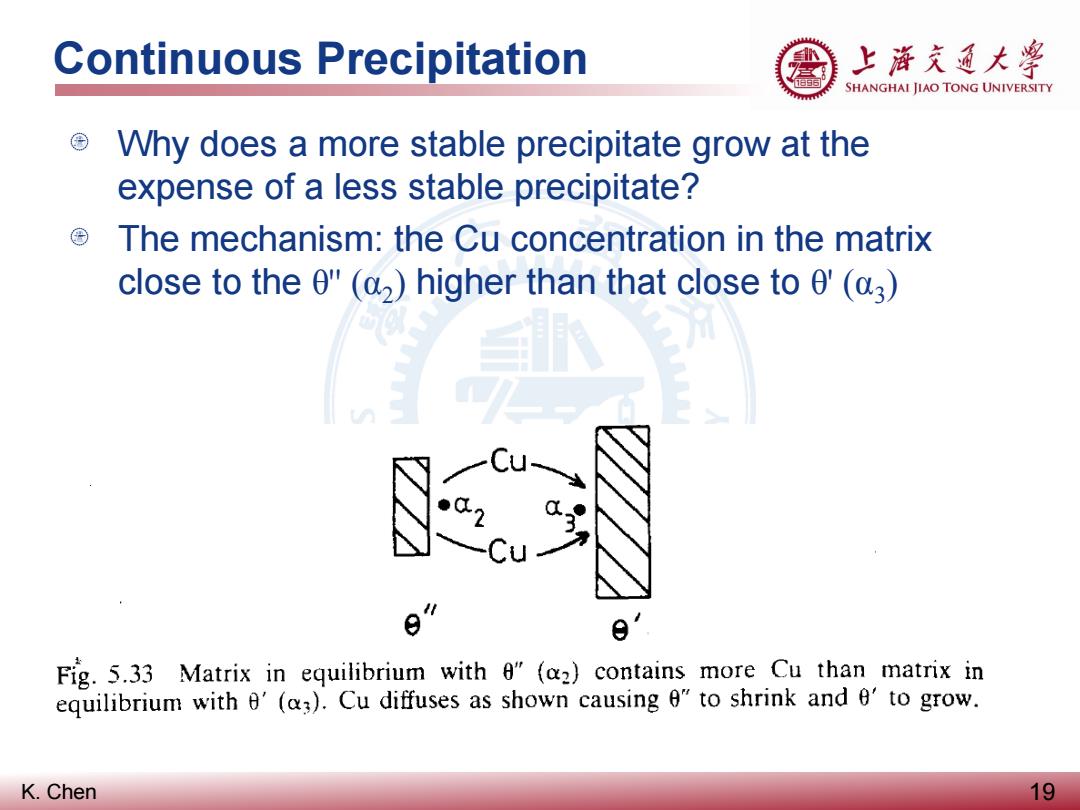
Continuous Precipitation 上游充通大兽 SHANGHAI JIAO TONG UNIVERSITY Equilibrium phase -0 Large size and coarse distribution No strain field,no misfit dislocation ×8000 K.Chen 16
K. Chen Continuous Precipitation 16 Equilibrium phase – θ Large size and coarse distribution No strain field, no misfit dislocation X 8000

Continuous Precipitation 上游充通大兽 SHANGHAI JIAO TONG UNIVERSITY Nucleation Sites: 0"nucleation:in situ transformation from GP zones 0'nucleation:on matrix dislocations with two orientations of 0' plates on any one <110>dislocations,after longer ageing time; rather than from 0" 0 nucleation:either on grain boundaries or at 0'/matrix interfaces GB a Dissolution of Fig.5.31 Electron micrographs showing nucleation sites in Al-Cu alloys. less stable 0" (a)8"-0'.e'nucleates at dislocation (x 70 000).(b)8 nucleation on grain bound- ary (GB)(x 56 000).:c)0'-0.8 nucleates at 8'/matrix interface (x 70 000). (After P.Haasen.Physical Metallurgy.Cambridge University Press, Cambridge. 1978.) K.Chen 17
K. Chen Continuous Precipitation 17 Nucleation Sites: θ'' nucleation: in situ transformation from GP zones θ' nucleation: on matrix dislocations with two orientations of θ' plates on any one 𝑎𝑎 2 <110> dislocations, after longer ageing time; rather than from θ'' θ nucleation: either on grain boundaries or at θ'/matrix interfaces Dissolution of less stable θ

Continuous Precipitation 上游充通大兽 SHANGHAI JIAO TONG UNIVERSITY Aging temperature and TTT diagram Full sequence of precipitation is only possible when aged at a T below the GP zones solvus Reversion(▣归现象):If an alloy containing GP zones is heated to above the GP zone solvus,the zones will dissolve. Higher nucleation rate>faster transformation rate finer precipitate distribution GP zones Fast nucleation rate (a) %Cu (b) Log (time) Fig.5.32 (a)Metastable solvus lines in Al-Cu (schematic).(b)Time for start of precipitation at different temperatures for alloy X in (a). K.Chen 18
K. Chen Continuous Precipitation 18 Aging temperature and TTT diagram Full sequence of precipitation is only possible when aged at a T below the GP zones solvus Reversion (回归现象): If an alloy containing GP zones is heated to above the GP zone solvus, the zones will dissolve. Higher nucleation rate faster transformation rate & finer precipitate distribution Fast nucleation rate

Continuous Precipitation 上浒充通大粤 SHANGHAI JIAO TONG UNIVERSITY © Why does a more stable precipitate grow at the expense of a less stable precipitate? The mechanism:the Cu concentration in the matrix close to the 0"(a2)higher than that close to 0'(a3) Fig.5.33 Matrix in equilibrium with 8"(z)contains more Cu than matrix in equilibrium with 0'(a3).Cu diffuses as shown causing 0"to shrink and e'to grow. K.Chen 19
K. Chen Continuous Precipitation 19 Why does a more stable precipitate grow at the expense of a less stable precipitate? The mechanism: the Cu concentration in the matrix close to the θ'' (α2) higher than that close to θ' (α3)

Continuous Precipitation 上游充道大粤 SHANGHAI JIAO TONG UNIVERSITY Quenched-in Vacancies Vacancy concentration increase with solution treatment(固溶处理)temperature increase High vacancy concentration can be quenched-in if the alloy is rapidly quenched from the high temperature Vacancy>nucleation site and increasing the diffusion rate>Promote the formation of GP zones Ni Cu Ni Cu Ni Cu increasing elapsed time K.Chen 20
K. Chen Continuous Precipitation 20 Quenched-in Vacancies Vacancy concentration increase with solution treatment (固溶处理) temperature increase High vacancy concentration can be quenched-in (冻结) if the alloy is rapidly quenched from the high temperature Vacancy nucleation site and increasing the diffusion rate Promote the formation of GP zones Ni Cu Ni Cu Ni Cu